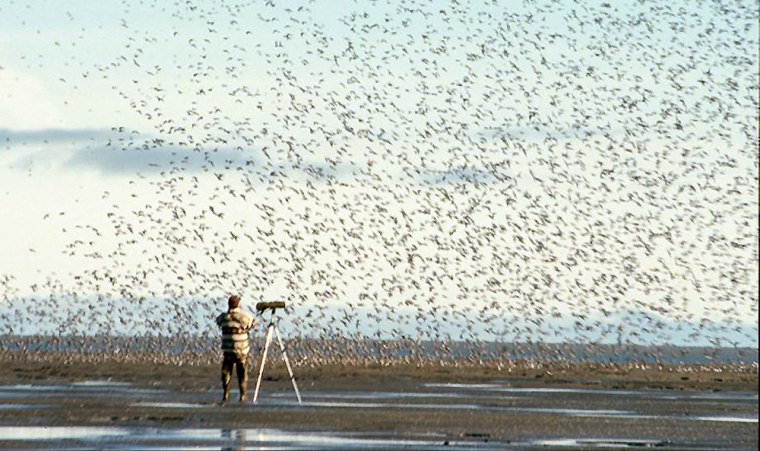Hundreds of miles above the Arctic Circle, biologists working in the frosty marshes of Alaska’s North Slope are keeping a lookout for migratory birds that might bring a deadly avian flu strain to the United States.
Interior Secretary Dirk Kempthorne, visiting a bird nesting site outside Barrow, reported Tuesday that 13,000 bird samples have been tested. While some less virulent forms of the flu were found, there has been no sign of the deadly H5N1 strain, linked to the death of at least 141 people, mostly in Asia.
“I think it’s going very well,” Kempthorne told The Associated Press after he helped a volunteer biologist gather a test sample from a young Dunin shorebird at a site on Beaufort Sea, near the northernmost point in the United States.
The fowl offspring’s parents likely flew here from Japan or Korea, Audrey Taylor, the volunteer, told Kempthorne.
Deborah Rocque, the bird flu testing coordinator for the U.S. Fish and Wildlife Service in Alaska, said the program is concentrating on testing on the North Slope and the Yukon Delta. Both are areas where tens of thousands of migratory birds nest in the summer after arriving from Asia.
“Some go straight back to Asia and some go right down the Pacific Flyway,” Rocque said.
Kempthorne, making his first visit to Alaska’s North Slope, was to take a helicopter tour later Tuesday over Lake Teshekpuk, an environmentally sensitive region where the department is putting oil leases up for sale despite protests from conservationists.
He said he has no plans to postpone the lease sale, scheduled for late September and that he believes the restrictions on drilling will protect wildlife, including caribou and nesting birds.
“It is a national petroleum reserve. That’s what the reserve is,” Kempthorne said of the vast area west of the Prudhoe Bay oil fields. The area was set aside in 1923 for its energy resource, but there has been no production to date.
Amid the lagoons and wetlands that dot the miles of Alaska tundra, hundreds of thousands of wild birds — geese, swans, mallards and loons — have been nesting on the North Slope, preparing for their annual flight south in the coming weeks.
Biologists wonder whether some of the globe-trotting fowl might carry the deadly bird flu virus that was discovered nearly a decade ago in Asia and since has hopped continents, surfacing in Africa, Europe and the Middle East. More than 180 people have been infected, and at least 141 have died from the virus, and 200 million birds, mostly poultry, have been destroyed to contain the disease.
The Fish and Wildlife Service and the Agriculture Department have been testing bird samples since April, concentrating on Alaska where the first sign of the highly pathogenic form of the bird flu virus might surface.
Interior officials said Tuesday that of the 13,000 samples taken so far, 113 birds tested positive “to some form of influenza” that poses no threat to humans. But no evidence of the more potent H5N1 strain has been found. Biologists expected coming across low-level flu samples since there are 144 subtypes of bird flu, most of which are not harmful to humans.
The Alaska studies have targeted 26 species because their migratory patterns are most likely to meet the H5N1 strain before arriving in Alaska.
Wherever the disease has spread to humans, it has been through people’s direct contact with the birds, mostly in Asia involving poultry. While no transfer of the bird flu among humans has been documented, scientists fear it eventually could mutate and spread from person to person, causing a flu pandemic.
The $29 million bird flu monitoring program hopes to test between 50,000 and 75,000 birds, said Dale Hall, head of the Fish and Wildlife Service. Earlier this month, the government announced that testing would be expanded to cover the entire nation.
Biologists test tissue samples or feces of both live birds, who are tagged and then released, and of dead birds brought in by hunters.
The test samples are sent to a laboratory in Madison, Wis., and those showing an h5 strain are sent to the Agriculture Department lab in Ames, Iowa, to determine if it might have the highly dangerous form. Nine samples containing the H5 strain have been sent to Ames, but none was found to have the H5N1 virus, Rocque said.
